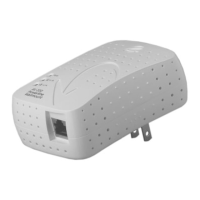
Do you have a question about the Corinex AV200 and is the answer not in the manual?
| Type | Powerline Ethernet Adapter |
|---|---|
| Model | AV200 |
| Standard | HomePlug AV |
| Data Rate | 200 Mbps |
| Encryption | 128-bit AES |
| Operating Temperature | 0°C to 40°C |
| Operating Humidity | 10% to 90% non-condensing |
| Ports | 1 x RJ45 |
| Power Supply | Integrated |
Introduces the Corinex AV200 Powerline Ethernet Wall Mount F adapter and its capabilities.
Explains the purpose and content of the user guide for the adapter.
Lists all items included in the product packaging for setup.
Details the necessary hardware and software for operation.
Describes the physical layout, buttons, and ports of the device.
Explains the meaning and status of the VPI and ETH indicator lights.
Details the available physical ports on the adapter.
Explains the core operational functions of the adapter.
Provides instructions to restore the adapter to its original factory settings.
Explains the VPI and ETH LED indicators and their operational meanings.
Lists the technical specifications of the AV200 Powerline Ethernet Wall Mount F.
Step-by-step guide on how to physically connect the adapter to a computer.
Describes the authentication page for accessing configuration settings.
Presents the initial status overview and general information of the adapter.
Provides detailed system, MAC, and network status information about the adapter.
Covers details on frequency notches and power control mechanisms.
Shows settings for IGMP and multicast bindings.
Indicates the status of VLAN configuration and associated tags.
Details traffic priority settings and classification criteria.
Shows whether the configuration page is protected by a password.
Explains how to modify adapter settings and the effect of changes.
Covers essential settings like Network ID and encryption for security.
Introduces advanced settings for network customization.
Details how to configure adapter types and network topology.
Covers setting MAC type, node type, network identifier, and encryption key.
Illustrates network configurations with different Network Identifiers.
Guides on setting up fixed IP addresses, subnet masks, and gateways.
Explains frequency transmission range and notch settings.
Details how to optimize multicast traffic and use IGMP.
Covers configuring VLAN tagging for traffic differentiation.
Explains the VPI LED behavior and how speed markers are set.
Allows setting default priority and custom classification criteria.
Illustrates the process of classifying network traffic based on packet patterns.
Manages password settings for configuration access and factory reset.
Describes the procedure for performing a physical hardware reset of the adapter.
Outlines the process for upgrading firmware, loader, or factory settings.
Provides specific steps for updating firmware via a TFTP server.
Explains how to prioritize video traffic for better performance.
Introduces In-Home AV networks, Access Points (AP), and End Points (EP).
Presents various scenarios for setting up AV200 Powerline networks.
Describes the default, open network configuration.
Explains how to create a secure, private network with an ID.
Illustrates basic network setups with multiple adapters.
Shows a setup for Internet and digital video distribution.
Discusses scenarios involving multiple networks with different IDs.
Explains how independent networks behave.
Describes how networks on the same circuit coexist and share channels.
Guides on setting a static IP address on a computer for device configuration.
Step-by-step instructions for configuring a static IP in Windows XP.
Details the process of setting IP properties in Windows XP.
Instructions for setting a static IP address in Windows 2000.
Details the process of setting IP properties in Windows 2000.
Steps to configure a static IP in Windows 98.
Commands for setting a static IP address in a Linux environment.
Shows the output of the Linux command for IP configuration.
Instructions for configuring a static IP address in Mac OS.
Details the process of setting IP and subnet mask in Mac OS.
Explains how to optimize network performance using system scripts.
Guides on monitoring network connection status and throughput.
Explains the purpose and application of powerline filters.
Illustrates scenarios for using powerline filters to isolate networks or noise.
Addresses issues related to the POWER, Powerline Act, and Ethernet LEDs being off.
Provides solutions for intermittent or poor network connectivity.
Lists essential safety measures to prevent injury and system damage.
Explains how to use the ping utility to diagnose network problems.
Lists information required when contacting customer support for assistance.